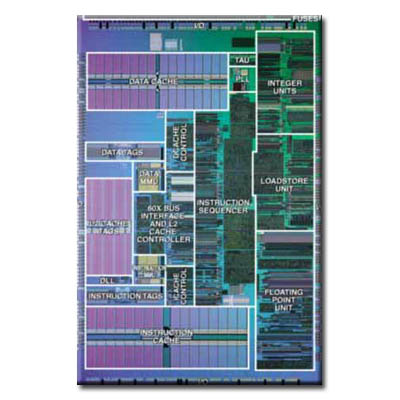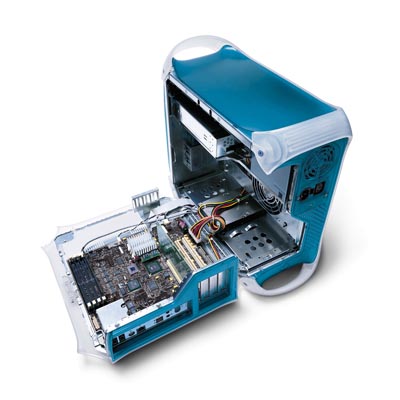IBM PowerPC G3 (740, 750...) processors
Introduction: 1997
PowerPC G3 is a designation used by Apple Computer to a third generation of PowerPC microprocessors from the PowerPC 750 family designed and manufactured by IBM and Motorola/Freescale. The term is often, incorrectly, imagined to be a physical model of processor when in fact a number of processors from different vendors have been used.
The G3 is a RISC-based microprocessor, belonging to the PowerPC family of processors. Such designations were applied to Apple Macintosh computers such as the PowerBook G3, the multicolored iMacs, iBooks and several desktops, including both the Beige and Blue and White Power Macintosh G3s. The low power requirements and small size made the processors ideal for laptops and the name lived out its last days at Apple in the iBook. The 750 family processors is widely used in embedded devices like printers and storage devices, spacecraft and game consoles from Nintendo, and is also used in other PowerPC based computers, like newer Amigas and Pegasos.
The PowerPC 740/750 design (codename Arthur) was introduced in late 1997 as an evolutionary replacement for the PowerPC 603e. Enhancements included faster memory bus (66MHz), larger L1 caches (32KB instruction and 32KB data), enhanced integer and floating point units and higher core frequency. The 750 model also included an option of 256, 512 or 1024KB external L2 cache.
The 740/750 models had 6.35 million transistors and was initially manufactured by IBM and Motorola in an aluminium based fabrication process. The die measured 67 mm² at 0.26 µm and it reached speeds of up to 366MHz while consuming 7.3W. In 1999, IBM used a copper based process at 0.20 µm which increased the frequency up to 500MHz and decreased power consumption to 6W and the die size to 40 mm².
The PPC 740 slightly outperformed Pentium IIs while consuming far less power, and were smaller in size. The off-die L2 cache of the 750 increased performance by approximately 30% in most situations. The design was so successful that it quickly beat PowerPC 604e in performance and a planned successor to 604 was scrapped.
The PowerPC 750 was used in many computers from Apple, including the original iMac.
RAD750 is a radiation-hardened processor, based on the PowerPC 750. It is intended for use in high radiation environments such as experienced on board satellites and spacecraft. The RAD750 was released for purchase in 2001. The Mars Reconnaissance Orbiter spacecraft has a RAD750 on board.
The processor has 10.4 million transistors, is manufactured by BAE Systems using 250 nm process and has a die area of 130 mm². It oprerates at 133-166MHz. The CPU itself can withstand 200,000 Rads and temperature ranges between -55ºC and 125ºC. The RAD750 packaging and logic functions has a price tag in excess of US$200,000: the high price is mainly due to radiation hardening revisions to the PowerPC 750 architecture and manufacturing, stringent quality control requirements, and extended testing of each processor chip manufactured.
Motorola revised the 740/750 design in 1998 and shrunk die size to 51 mm² thanks to a newer aluminium based facrication at 0.22 µm. The speeds increased to up to 600MHz. The 755 were used in some iBook models. After this model, Motorola chose not to keep developing the 750 processors in favour of their PowerPC 7400 processor and other cores.
IBM continued developing the 750 line and introduced 750CX (codename Sidewinder) in 2000 with 256KB on-die L2 cache; this increased performance while reducing power consumption and complexity. At 400MHz, it drew under 4W. The 750CX had 20 million transistors including its L2 cache. It had a die size of 43 mm² through a 0.18 µm copper process. 750CX was only used in one iMac revision.
750CXe (codename Anaconda), introduced in 2001, was a minor revision of 750CX which increased its frequency up to 700 and memory bus to 133MHz, from 100MHz. The 750CXe also featured improved floating-point performance over the 750CX. Several models of iBook and the last G3 based iMac used this processor.
A cost reduced version of 750CXe, called 750CXr, is available at lower frequencies.
Gekko is the custom central processor for the Nintendo GameCube game console. It is based on a PowerPC 750CXe and adds about 50 new instructions as well as a modified FPU capable of some SIMD funtionality. It has 256KB of on die L2 cache, operates at 485MHz with a 162MHz memory bus, is manufactured by IBM on a 180 nm fabrication processor. The die is 43 mm² large.
The 750FX (codenamed Sahara) came in 2002 and increased frequency up to 900MHz, the bus speed to 166MHz and the on-die L2 cache to 512KB. It also featured a number of improvements to the memory subsystem: an enhanced and faster (200MHz) 60x bus controller, a wider L2 cache bus, the ability to lock parts of the L2 cache. It is manufactured using a 0.13 µm copper based fabrication with Low-K dielectric and Silicon on insulator technology. 750FX has 39 million transistors, a die size of 35 mm² and consumes less than 4W at 800MHz at typical loads. It was the last G3 type processor used by Apple.
A low powered version of 750FX is available called 750FL.
750GX (codenamed Gobi), revealed in 2004 is the latest and most powerful G3 processor from IBM. It has a on-die L2 cache of 1MB, top frequency of 1.1GHz, support bus speeds up to 200MHz among other enhancements compared to 750FX. It is manufactured using a 0.13 µm copper based fabrication with Low-K dielectric and Silicon on insulator technology. The 750GX has 44 million transistors, a die size of 52 mm² and consumes less than 9W at 1GHz at typical loads.
A low powered version of 750GX is available called 750GL.
750CL is an evolved 750CXe, with speeds ranging from 400MHz to 1GHz with a system bus up to 240MHz, L2 cache prefetch features and graphics related instructions have been added to improve performance. As the added graphics-related functions match closely the ones found in the Gekko processor it is very likely that the 750CL is a shrink of the said processor for general purpose use. The 750CL is manufactured using a 90 nm copper based fabrication with Low-K dielectric and Silicon on insulator technology. It has 20 million transistors and the die is 16 mm² small. It draws up to 2.7W at 600MHz, 9.8W at 1GHz.
Source: Wikipedia, the free encyclopedia.




